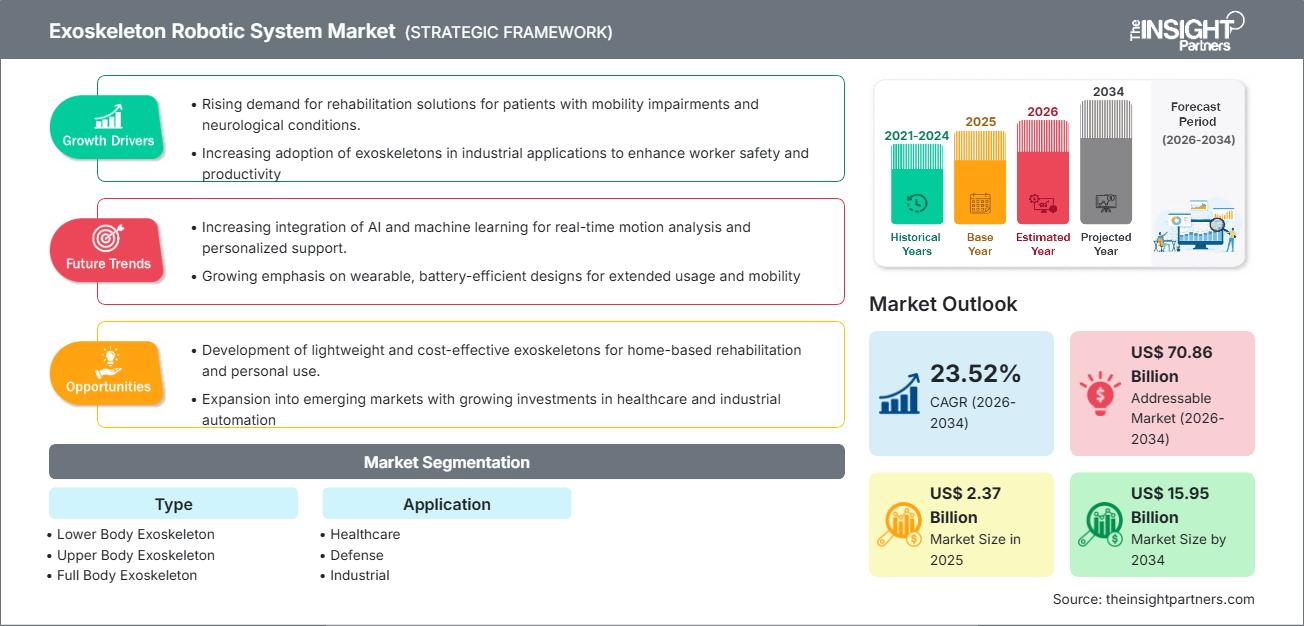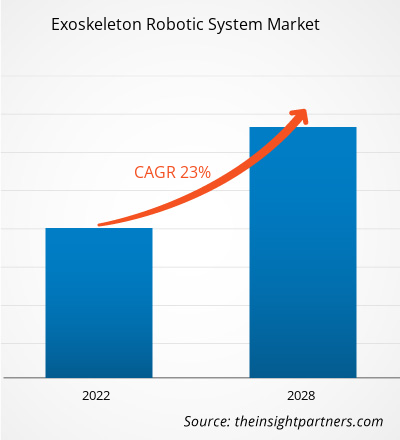Der Markt für Exoskelett-Robotiksysteme wird voraussichtlich ein beispielloses Wachstum verzeichnen und bis 2034 auf 15,95 Milliarden US-Dollar ansteigen, gegenüber geschätzten 2,37 Milliarden US-Dollar im Jahr 2025. Für diesen Markt wird im Prognosezeitraum 2026–2034 eine äußerst hohe durchschnittliche jährliche Wachstumsrate (CAGR) von 23,52 % erwartet.
Marktanalyse für Exoskelett-Robotiksysteme
Die Prognose für den globalen Markt für Exoskelett-Robotiksysteme deutet auf ein starkes, rasantes Wachstum hin, das im Wesentlichen durch zwei Schlüsselfaktoren getrieben wird: die Konvergenz von fortschrittlicher Robotik und künstlicher Intelligenz (KI) sowie der steigende Bedarf an Mobilitätswiederherstellung im Gesundheitswesen und an der Unterstützung menschlicher Fähigkeiten in Industrie und Verteidigung. Die klinische Anwendung in Rehabilitationszentren zur Behandlung von Rückenmarksverletzungen, Schlaganfällen und Multipler Sklerose, wo Exoskelette das Gangtraining und die Behandlungsergebnisse deutlich verbessern, treibt die Marktexpansion voran. Darüber hinaus sorgen die Bemühungen der Industrie um die Prävention von Verletzungen und die Steigerung der Arbeitsproduktivität sowie staatliche Investitionen in zukunftsweisende Technologien zur Unterstützung von Soldaten im Verteidigungsbereich für vielfältige Einnahmequellen. Kontinuierliche technologische Innovationen bei der Anwendung von leichten Kohlenstofffaserverbundwerkstoffen, verbesserter Hochleistungsbatterietechnologie und hochentwickelten KI-Algorithmen zur Echtzeit-Bewegungsvorhersage und personalisierten Unterstützung verbessern die Benutzerfreundlichkeit der Geräte, senken die Gesamtbetriebskosten und beschleunigen so die globale Marktdurchdringung.
Marktübersicht für Exoskelett-Robotiksysteme
Exoskelett-Robotiksysteme sind hochentwickelte, tragbare elektromechanische Geräte, die am Körper befestigt werden, um physische Unterstützung, Kraftzuwachs oder Mobilitätshilfen zu bieten. Diese Systeme nutzen motorisierte Gelenke, Sensoren und leistungsstarke Steuerungssoftware, um entweder verlorene Funktionen wiederherzustellen (Rehabilitation) oder bestehende menschliche Fähigkeiten zu erweitern (Industrie/Militär). Sie sind unverzichtbare Hilfsmittel im Gesundheitswesen und ermöglichen es Querschnittsgelähmten, wieder zu stehen und zu gehen; in der Industrie reduzieren sie die Belastung durch repetitive Aufgaben und schweres Heben; und im Verteidigungsbereich erhöhen sie die Ausdauer von Soldaten beim Tragen schwerer Kampflasten. Der Markt ist geprägt von intensiver Forschung und Entwicklung, einem komplexen und strengen Zulassungsverfahren (insbesondere für Medizinprodukte) sowie strategischen Kooperationen zwischen spezialisierten Robotikunternehmen und etablierten Rüstungs- und Luftfahrtunternehmen zur Kommerzialisierung spezialisierter Systeme.
Passen Sie diesen Bericht Ihren Anforderungen an.
Sie erhalten eine kostenlose Anpassung aller Berichte – einschließlich Teilen dieses Berichts, Länderanalysen und Excel-Datenpaketen – sowie attraktive Angebote und Rabatte für Start-ups und Universitäten.
Markt für Exoskelett-Robotiksysteme: Strategische Einblicke

-
Ermitteln Sie die wichtigsten Markttrends dieses Berichts.Diese KOSTENLOSE Probe beinhaltet eine Datenanalyse, die von Markttrends bis hin zu Schätzungen und Prognosen reicht.
Markttreiber und Chancen für Exoskelett-Robotiksysteme
Markttreiber:
- Steigende Nachfrage nach fortschrittlichen Rehabilitationslösungen im Gesundheitswesen: Die weltweit wachsende Zahl älterer Menschen und die zunehmende Verbreitung neurologischer Erkrankungen (wie Schlaganfall und Parkinson) erfordern fortschrittliche, technologiegestützte Rehabilitationstherapien. Exoskelette ermöglichen ein hochintensives, repetitives und messbares Gangtraining, das für die Neuroplastizität von entscheidender Bedeutung ist.
- Zunehmender Einsatz von Robotik im Verteidigungs- und Industriesektor: Im Industriesektor mindern Exoskelette Muskel-Skelett-Erkrankungen, die durch lang anhaltende Überkopfarbeiten oder schweres Heben entstehen, und erhöhen so die Arbeitssicherheit und die betriebliche Effizienz. Im Verteidigungsbereich verlängern motorisierte Exoskelette die Einsatzdauer, insbesondere bei Logistik- und Aufklärungsoperationen.
- Technologische Fortschritte bei KI und Leichtbaumaterialien: Die Integration von maschinellem Lernen in Steuerungssysteme ermöglicht es Exoskeletten, sich besser an den individuellen Gang und die Absichten des Nutzers anzupassen. Gleichzeitig verbessert die Verwendung leichter, aber dennoch robuster Materialien den Tragekomfort, die Akkulaufzeit und die allgemeine Benutzerfreundlichkeit bei längerem Tragen deutlich.
Marktchancen:
- Expansion in Schwellenländern mit verbesserter Gesundheitsinfrastruktur: Da die Volkswirtschaften im asiatisch-pazifischen Raum und in Lateinamerika stark in modernisierte Rehabilitationszentren und industrielle Sicherheitsstandards investieren, stellen diese Regionen große, unterversorgte Märkte dar, die sich für den Einsatz von Exoskeletten eignen.
- Entwicklung kostengünstiger und portabler Exoskelettsysteme: Aktuelle Systeme sind oft teuer und daher schwer zugänglich. Es bestehen Möglichkeiten zur Entwicklung modularer, passiver und kostengünstigerer aktiver Geräte (weiche Exoskelette), die sich leicht von kleinen Kliniken, Heimanwendern und kleinen Produktionsstätten einsetzen lassen.
- Strategische Partnerschaften für Innovation und globalen Vertrieb: Die Zusammenarbeit zwischen regionalen Anbietern von Rehabilitationsdienstleistungen und multinationalen Technologieentwicklern ist der Schlüssel zur Bewältigung komplexer regulatorischer Prozesse und zum Aufbau umfassender Service- und Wartungsnetzwerke, die für hochwertige Medizinprodukte von entscheidender Bedeutung sind.
Marktbericht für Exoskelett-Robotiksysteme: Segmentierungsanalyse
Der Marktanteil von Exoskelett-Robotiksystemen wird nach unterstützten Körperteilen, primären therapeutischen oder funktionellen Anwendungen und technologischen Aspekten analysiert und bietet so eine klare Struktur der Marktdynamik. Nachfolgend ist der in den meisten Branchenberichten verwendete Standard-Segmentierungsansatz dargestellt:
Nach Typ:
- Exoskelett für den Unterkörper
- Exoskelett für den Oberkörper
- Ganzkörper-Exoskelett
Auf Antrag:
- Gesundheitswesen/Rehabilitation
- Industrie
- Verteidigung
Nach Geographie:
- Nordamerika
- Europa
- Asien-Pazifik
- Süd- und Mittelamerika
-
Naher Osten und Afrika
Markteinblicke für Exoskelett-Robotiksysteme – Regionale Erkenntnisse
Die regionalen Trends und Einflussfaktoren auf den Markt für Exoskelett-Robotiksysteme im gesamten Prognosezeitraum wurden von den Analysten von The Insight Partners eingehend erläutert. Dieser Abschnitt behandelt außerdem die Marktsegmente und die geografische Verteilung des Exoskelett-Robotiksystems in Nordamerika, Europa, Asien-Pazifik, dem Nahen Osten und Afrika sowie Süd- und Mittelamerika.
Berichtsumfang zum Markt für Exoskelett-Robotiksysteme
| Berichtattribute | Details |
|---|---|
| Marktgröße im Jahr 2025 | 2,37 Milliarden US-Dollar |
| Marktgröße bis 2034 | 15,95 Milliarden US-Dollar |
| Globale durchschnittliche jährliche Wachstumsrate (2026 - 2034) | 23,52 % |
| Historische Daten | 2021-2024 |
| Prognosezeitraum | 2026–2034 |
| Abgedeckte Segmente |
Nach Typ
|
| Abgedeckte Regionen und Länder |
Nordamerika
|
| Marktführer und wichtige Unternehmensprofile |
|
Marktdichte der Akteure im Bereich Exoskelett-Robotiksysteme: Auswirkungen auf die Geschäftsdynamik verstehen
Der Markt für Exoskelett-Robotiksysteme wächst rasant, angetrieben durch die steigende Nachfrage der Endnutzer. Gründe hierfür sind unter anderem sich wandelnde Verbraucherpräferenzen, technologische Fortschritte und ein wachsendes Bewusstsein für die Vorteile des Produkts. Mit steigender Nachfrage erweitern Unternehmen ihr Angebot, entwickeln innovative Lösungen, um den Kundenbedürfnissen gerecht zu werden, und nutzen neue Trends, was das Marktwachstum zusätzlich beflügelt.

- Verschaffen Sie sich einen Überblick über die wichtigsten Akteure auf dem Markt für Exoskelett-Robotiksysteme.
Marktanteilsanalyse für Exoskelett-Robotiksysteme nach Regionen
Das Wachstum des Exoskelett-Marktes ist stark konzentriert und spiegelt globale Unterschiede bei den Gesundheitsausgaben, dem Automatisierungsgrad der Industrie und den Beschaffungsrichtlinien im Verteidigungsbereich wider. Nachfolgend finden Sie eine Zusammenfassung der Marktanteile und Trends nach Regionen:
Nordamerika
- Marktanteil: Dominiert den Weltmarkt, angetrieben durch erhebliche Investitionen in Forschung und Entwicklung, die frühe und umfassende Einführung robotischer Rehabilitationstherapien sowie umfangreiche militärische Beschaffungsprogramme.
- Wichtigste Einflussfaktoren: Hohe Gesundheitsausgaben, wegweisende regulatorische Rahmenbedingungen für Medizinprodukte (FDA) und eine starke Präsenz sowohl etablierter Rüstungsunternehmen als auch wachstumsstarker Robotik-Startups.
- Trends: Schnelle Integration von Systemen mit Telemedizinplattformen zur Fernüberwachung von Patienten; zunehmende Kostendeckung für medizinische Exoskelette durch die Krankenkassen.
Europa
- Marktanteil: Verfügt über einen bedeutenden Marktanteil, der durch robuste öffentliche Gesundheitssysteme und eine starke regulatorische Ausrichtung durch die CE-Kennzeichnung unterstützt wird.
- Wichtigste Einflussfaktoren: Hohe Akzeptanzrate der industriellen Automatisierung (Deutschland, nordische Länder) zur Aufrechterhaltung der Sicherheitsstandards am Arbeitsplatz; Fokus der Regierung auf die Finanzierung innovativer Rehabilitationstechnologien.
- Trends: Schwerpunkt auf der Entwicklung leichter, modularer Systeme, die für den Einsatz in der Bevölkerung außerhalb formaler klinischer Einrichtungen geeignet sind; strenge Datenschutzbestimmungen (DSGVO) für Medizinprodukte.
Asien-Pazifik
- Marktanteil: Die am schnellsten wachsende Region, aufgrund der rasanten Modernisierung der Gesundheitsinfrastruktur und einer massiven Industrie-/Produktionsbasis, die Automatisierungslösungen sucht.
- Wichtigste Einflussfaktoren: Steigende Investitionen in die heimische Robotik-Forschung und -Entwicklung (China, Japan, Südkorea); expandierender privater Gesundheitssektor; staatliche Initiativen zur Förderung der Technologieakzeptanz in der Altenpflege und der Produktionssicherheit.
- Trends: Starke lokale Fertigungskapazitäten führen zur Entwicklung kostengünstigerer Alternativen; Fokus auf die Integration von Exoskeletten in groß angelegte Fabrikabläufe.
Süd- und Mittelamerika
- Marktanteil: Aufstrebender Markt mit derzeit geringer Marktdurchdringung, aber erheblichem Zukunftspotenzial.
- Wichtigste Einflussfaktoren: Expansion privater Kliniken und spezialisierter Rehabilitationszentren; zunehmendes Bewusstsein für fortschrittliche Mobilitätstechnologien bei vermögenden Privatpersonen.
- Trends: Allmähliche Übernahme importierter, oft einfacherer Exoskelette; Nutzung von Partnerschaften zur Überwindung von Importbarrieren und zum Aufbau lokaler Wartungsunterstützung.
Naher Osten und Afrika
- Marktanteil: Entwicklungsmarkt, stark abhängig von gezielten staatlichen Ausgaben.
- Wichtigste Triebkräfte: Staatlich finanzierte nationale E-Health- und Infrastrukturausbauprojekte (insbesondere in den GCC-Staaten); gezielte Investitionen in fortschrittliche Medizintechnologien zur Stärkung des Rufs als regionale Gesundheitszentren.
- Trends: Einsatz modernster Systeme in hochspezialisierten medizinischen Zentren; Wachstum getrieben durch militärische und sicherheitsrelevante Anwendungen (Verteidigung).
Marktdichte der Akteure im Bereich Exoskelett-Robotiksysteme: Auswirkungen auf die Geschäftsdynamik verstehen
Hohe Marktdichte und starker Wettbewerb
Der Markt ist hart umkämpft und fragmentiert; er ist aufgeteilt zwischen hochspezialisierten Medizingeräteherstellern, großen Unternehmen der Industrieautomation und Rüstungskonzernen. Zu den wichtigsten Wettbewerbsfaktoren zählen Akkulaufzeit, Gewichtsreduzierung, intuitive Bedienalgorithmen und Daten zur klinischen Wirksamkeit.
Differenzierung wird erreicht durch:
- Klinische Wirksamkeit und behördliche Zulassung: Für medizinische Systeme hängt die Differenzierung von überlegenen klinischen Daten ab, die schnellere oder bessere Rehabilitationsergebnisse belegen und günstige Erstattungscodes sichern.
- KI und Steuerungssysteme: Die Entwicklung intelligenterer, vorausschauenderer Steuerungssoftware, die die Absicht des Benutzers fehlerfrei erkennt, ist ein entscheidender technologischer Wettbewerbsvorteil, der die Sicherheit und natürliche Bewegungsabläufe verbessert.
- Modularität und Anpassbarkeit: Wir bieten Systeme an, die sich leicht an unterschiedliche Patientengrößen oder Aufgaben anpassen lassen (z. B. durch Austausch von Hüftgelenken oder Armaufsätzen).
Die wichtigsten Unternehmen, die auf dem Markt für Exoskelett-Robotiksysteme tätig sind, sind:
- Lockheed Martin Corp
- Cyberdyne Inc
- Panasonic Holdings Corp
- Hocoma AG
- ReWalk Robotics Inc
- Ekso Bionics Holdings Inc
- Parker Hannifin Corp
- Myomo Inc
- B-Temia Inc
Hinweis: Die oben aufgeführten Unternehmen sind nicht in einer bestimmten Reihenfolge geordnet.
Marktneuigkeiten und aktuelle Entwicklungen im Bereich Exoskelett-Robotiksysteme
- Eine systematische Übersichtsarbeit des Global Spine Journal aus dem Jahr 2025, die 27 klinische Studien umfasste, bestätigte HAL als einziges Implantat, das Neuroplastizität in der Rehabilitation von Rückenmarksverletzungen nachweist. Im Juni 2025 unterzeichnete Cyberdyne zudem eine europäische Kooperationsvereinbarung mit der National Taiwan University und der Universität Tsukuba zur Förderung von Forschung und Entwicklung.
- Im Oktober 2025 trat Ekso dem NVIDIA Connect Programm bei, um die KI-Integration zu verbessern. Die CMS (Centers for Medicare & Medicaid Services) nahm das Ekso Indego Personal 2024 in die Medicare-Leistungen für Orthesen auf. Im August 2025 startete die Partnerschaft „SoldiersStrong“, um Veteranen zu unterstützen, die Exoskelette von Ekso nutzen.
- Myomo Inc. verzeichnete eine starke Finanzperformance und ein deutliches Patientenwachstum. Die Ergebnisse des dritten Quartals 2025 wiesen einen Umsatz von 9,7 Mio. US-Dollar und 816 eingeschriebene Patienten aus. Im Mai 2025 wurden für das erste Quartal ein Umsatz von 9,8 Mio. US-Dollar, 700 neu gewonnene Patienten und über 300 ausgebildete Prothetiker als zertifizierte Fachkräfte gemeldet.
Marktbericht zu Exoskelett-Robotiksystemen: Abdeckung und Ergebnisse
Der Bericht „Marktgröße und Prognose für Exoskelett-Robotiksysteme (2021–2034)“ bietet eine detaillierte Analyse des Marktes und deckt folgende Bereiche ab:
- Marktgröße und Prognose für Exoskelett-Robotiksysteme auf globaler, regionaler und Länderebene für alle wichtigen Marktsegmente, die im Geltungsbereich abgedeckt werden
- Markttrends für Exoskelett-Robotiksysteme sowie Marktdynamiken wie Treiber, Hemmnisse und wichtige Chancen
- Detaillierte PEST- und SWOT-Analyse
- Marktanalyse für Exoskelett-Robotiksysteme: Wichtige Markttrends, globale und regionale Rahmenbedingungen, Hauptakteure, regulatorische Rahmenbedingungen und aktuelle Marktentwicklungen
- Branchenlandschaft und Wettbewerbsanalyse mit Fokus auf Marktkonzentration, Heatmap-Analyse, prominente Akteure und aktuelle Entwicklungen auf dem Markt für Exoskelett-Robotiksysteme\
- Detaillierte Unternehmensprofile
- Historische Analyse (2 Jahre), Basisjahr, Prognose (7 Jahre) mit CAGR
- PEST- und SWOT-Analyse
- Marktgröße Wert/Volumen – Global, Regional, Land
- Branchen- und Wettbewerbslandschaft
- Excel-Datensatz
Aktuelle Berichte
Erfahrungsberichte
Grund zum Kauf
- Fundierte Entscheidungsfindung
- Marktdynamik verstehen
- Wettbewerbsanalyse
- Kundeneinblicke
- Marktprognosen
- Risikominimierung
- Strategische Planung
- Investitionsbegründung
- Identifizierung neuer Märkte
- Verbesserung von Marketingstrategien
- Steigerung der Betriebseffizienz
- Anpassung an regulatorische Trends






















 Kostenlose Probe anfordern für - Markt für Exoskelett-Robotiksysteme
Kostenlose Probe anfordern für - Markt für Exoskelett-Robotiksysteme